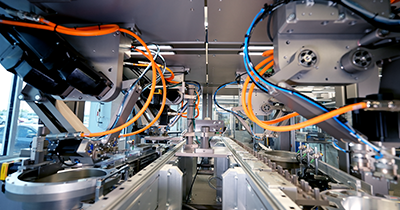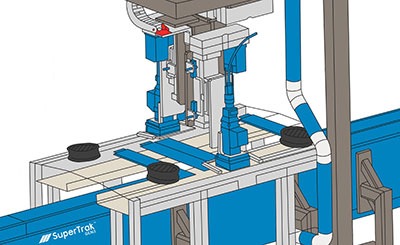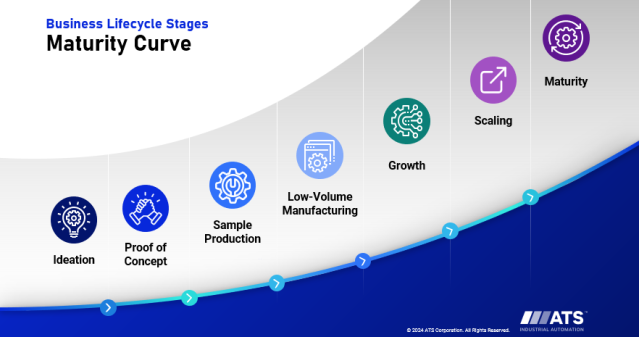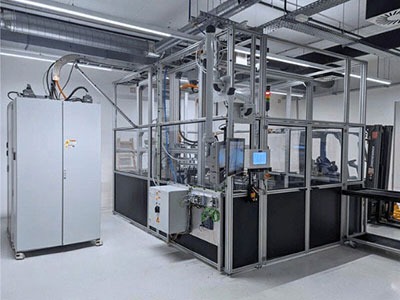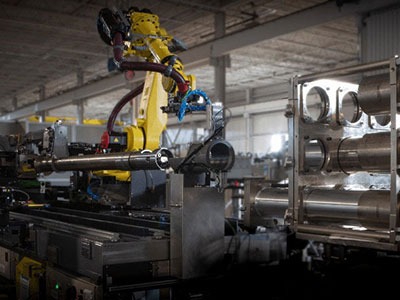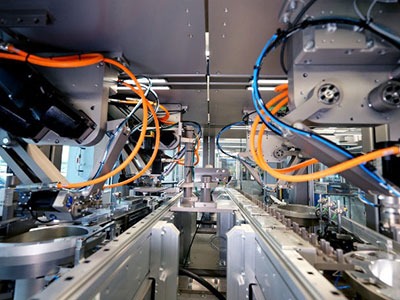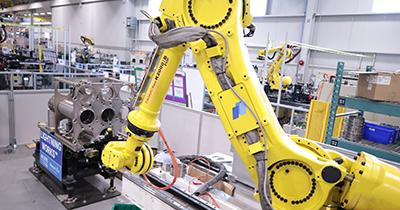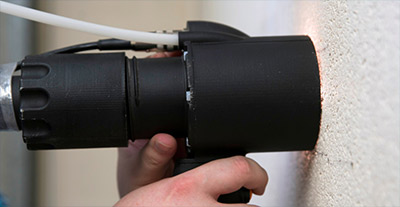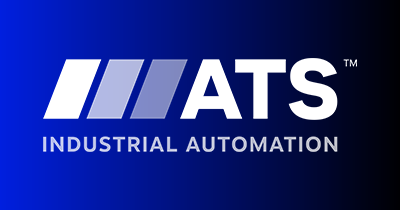December 5, 2022
2022 saw 66 EV platforms launched, and will double by 2024. The battery design is increasingly essential to the platform’s success, yet design changes are happening much further in the development process. Cell, Module, and Pack Testing solutions must be fast and support different form factors within the same line. But too often, companies move serial to solve the various battery form factors and specs. Multiple lines are inefficient, with a significantly larger footprint.
With over 90 Battery and Test Lines, ATS is the manufacturing partner in EV testing, helping customers go from a battery design to full-scale production testing that meets the continued pressure for increased throughput without compromising quality.
Featured topics:
- Top challenges for pack, module, and cell and the nuances in each area.
- How modularity and flexibility give scale within a small footprint, capitalizing on CapEx.
- How a manufacturing partner can be a knowledge asset in battery testing to successfully scale and meet launch targets.
Watch “The Tangram Issue in Battery Testing” Webinar Now
Speakers
Speaker
Srdjan Raickovic
Senior Electrical Designer Test Engineer, ATS Industrial Automation
Speaker
David Guiler
Test Specialist – EV Mobility, ATS Industrial Automation
Transcript
David Guiler
Welcome to the Tangram Issue with Battery Testing. During this presentation, we will explore the product testing challenges in the EV industry. As we reflect on two decades of EV automation.
Srdjan Raickovic
This is the Issue In Battery Testing virtual presentation. My name is Srdjan Raickovic, and I will be talking about some of the battery testing challenges with EV batteries and how they are evolving at an unprecedented pace. This presentation applies mainly to EV batteries and cylindrical cells, but it is transferable to the other battery types. I have been part of the ATS team for over 20 years designing test systems in a variety of fields including life sciences, consumer products, electronics, energy and traditional automotive programs.
David Guiler
Hello, my name is David Guiler. I’m a test specialist here at ATS. I focus primarily on leak testing, and the electrical connection interface to the product. I’ve been at ATS for seven years designing test equipment for various industries including medical, aerospace, energy grid, fuel cell, consumer products, and traditional automotive. With the shift to electrification, there have been a lot of opportunities to contribute to this exciting industry.
Key Takeaways
Srdjan Raickovic
Today we want to talk about four topics from here:
Why the cell is the first line of defense, and not the module and pack.
The top challenges for pack, module, and cell, and the nuances in each area.
How modularity and flexibility give scale within a small footprint, capitalizing on capital expenditure.
How a manufacturing partner can be a knowledge asset in battery testing to successfully scale and meet launch targets.
EV Expansion
According to predictions, electric vehicle sales could reach 33% globally by 2028, and 50% by 2035. To support that demand, automakers and suppliers now expect to invest at least $526 billion on electric vehicles and batteries from 2022 to 2026. Electric vehicle sales are surging due to a combination of policy support improvements in battery technology, more charging infrastructure, and new compelling models from automakers. The size of the electric vehicle market opportunity between today and 2050 is $53 trillion. The demand for batteries is expected to grow by around 30%, nearing 4500 gigawatt hours a year globally by 2030, and reaching an annual revenue as high as $410 billion. Approximately 90% of the demand will come from mobility applications, most importantly, electric vehicles. The global electric vehicle test equipment market size is projected to reach $242 million USD by 2027. Battery testing as a part of electric vehicle testing is important and required during the development, validation, production, and post-production stages of electric vehicles.
David Guiler
ATS Industrial Automation
ATS has over 20 years of battery manufacturing and testing experience. This testing experience includes having built 90+ assembly lines for storage, as well as test systems. This is all built based on our ATS Business Model (ABM) which really focuses on three primary pillars. The first pillar, we recruit the best talent to make sure that we have people that are going to give us that winning theme. The second pillar – because we focus on continuous improvement – we make sure that our process is sound and discipline. Finally, we have daily visual management, which tracks performance and makes sure that we’re always winning. We are able to win because we have a team of experts that know automation and testing limits. They are able to focus on delivering the best-in-class solutions.
This is all tied together with project management to make sure that we always foster positive customer relationships. We also have a global footprint, which allows us global support and scale. ATS is incredibly stable as it’s been around for over 40 years, and it expects a safe future. Here you can see part of our global footprint and global service. We also have our specialized test centers that are based out of Woodbridge and Wixom.
Batteries as the First Line of Defense
Srdjan Raickovic
Battery cells are assembled into modules or packs and connected in a series in parallelly to achieve a packs total voltage and current requirements. One pack can contain several 1000s of individual cells. Once cells are assembled into the module or pack, and the welding process is finalized, it is very difficult and most likely will not be cost effective to replace the defective cells. In case of a thermal event, a defective cell can damage a module and the entire pack, not to mention the safety risk.
In April 2020, the US NHTSA launched an investigation looking into the safety related defects in battery packs made by LG. According to the report, high voltage batteries made by LG had a defect that could ignite inside the battery cell raising the risk of a fire. As a result of that investigation, LG energy solutions reimbursed GM $2 billion for the recall costs. This illustrates how important and critical battery cell testing is as a first line of defense.
Remanufacturing at module level. There is currently no industrial application of remanufacturing up to a cell level, or batteries with a lithium-ion cell chemistry and welded cells, as the state of the art of the most current electric vehicle models are. In fact, while the first electric car batteries were assembled in small volumes and bolted connections were acceptable, the demands of high-volume manufacturing for stable and fast processes, as well as small and less valuable contact resistance, are better met by welding.
Multi-Plex Cell Automation
The number of cells in packs can be in the 1000s. Each of those cells must be tested for Open Circuit Voltage (OCV) and Alternating Current Internal Resistance (ACIR) before they get assembled into a module or pack. The test time for each cell significantly affects throughput of the battery packs. So, we want to test a larger number of cells as fast as possible.
In order to minimize test style and still have consistent and accurate results, the best approach is to automate the test and use a multitone multiplexer and bed of nails test fixture. Every bed of nails gets a certain number of nests, in our case is up to 64. Every nest has 4 pins to accommodate 4 wire resistance measurements. Once contact is made with the cell, the multiplexer starts scanning each of the cells so the OCV and ACIR measurements can be taken. This scan is executed sequentially and is 4 times smaller. With a smaller number of cells that might be fast enough, but for a larger number of cells, we might need to increase the test circuit 2,3,4 times, or even more, in order to achieve acceptable test times and throughput.
In fully automated assembly lines, tests can also be executed during the robot pick and place timing throughout. In this case, there is no need for a bed of nails. Cable lengths in the measurement circuit can be more specific lengths from the instruments to the test probes, which can affect their test results and test times. The longer cables can cause a decline in measurement signal quality. Also, the total resistance can be increased above the acceptable tolerance specified by instrument specification. In that case, stated instrument accuracy is not valid anymore. To compensate the degradation of the signal, you might not be able to use the fast measurement mode, which means a longer cycle time. The best practice is to have the shortest cable possible. Unfortunately, in a production environment, that is not always possible. Due to a limited footprint, very often we need to move instrumentation further away from the test probes. So, we developed a better layout to incorporate the test tooling directly into the automation. This modular method enabled the tools to be placed closer to the item being tested to allow for more accurate testing, lower cycle time, and increased throughput.
Test Executive
Here we can see the main screen of one of our battery cell tester applications. It shows the results of 256 individual cells tested for open circuit voltage and AC internal resistance. Color coded shading provides visual feedback of the status of each individual cell. Data can be uploaded to a remote server farm for in-process pass/fail determination or pass/fail determination can be done locally. In this case, all 256 cells are tested in less than 10 seconds. If you do some math, we can see that more than 700 cells can be tested in less than 30 seconds.
While I’m here I would like to mention the key features of our ATS battery cell test system as a standard product. These are scalability, modularity, and flexibility. ATS Test Executive features built into the system have high accuracy and precision instrumentation to measure open circuit voltage, and AC internal resistance for wire measurements for AC internal resistance and high-speed multiplex of the switch through the 256 cells. Using the four-quadrant bed of nails concept allows the test time per cell to be less than 10 milliseconds. As a standard, it has a probe bed of nails to test up to 256 batteries per tray. Optionally, the number of tested cells can be a standard above 256.
Module Challenges
Similar Yet Different
We start out with 1000s of cells in production and that means we need to be testing 1000s of them at the start. As you move down the assembly process these products are highly module. They’re built up of little packs, or sections of modules that consist of some number of cells, or pouches, or energy storage devices. Maybe it is 300 or 500 per section in a module. Now our rate that we need to process and run tests on starts to slow down.
We now look at the number of seconds per parameter we are going to be dealing with. When we get to the end we have a single completed pack, and we are looking at minutes per part. Not only do you have to look at the quantity of the parts but, the intermingled process. Part connections change. If you look at the testing across all of these parts, we are testing the same physical quantities as we go down the line. We have different connections for doing this. We have high voltage DC (direct current) connections, typically more towards the end of the line as the voltage gets built up. And we have low voltage DC connections that are usable for controlling the charge/discharge. For all levels, cell, module, and pack testing, the core challenges are the same; How to accommodate more and more demanding requirements for smaller footprints, higher accuracy, shorter cycle time, lower cost, faster delivery time, and higher power.
Variation in Modules
Every application is different. The kind of testing is required depends on the application. There is a variety of different types of modules and packs based on pack manufacturers preference.
Modules can have different sizes and shapes, different configurations meaning different combinations of number of cells connected in series in parallel. For example, it can be 54S and 2P, 14S and 2P, 3S and 40P, or 11S and 60P. Depending on the configuration, modules can have voltages from dozens to more than 100 volts, and current capacity from 5 to more than 500 amps per hour. Some of them don’t have cell management controllers, the ones that have a cell management controller can be with or without a battery management controller.
BMC (Battery Management Controller) can have different topologies, different communication protocols like CAN bus, isoSPI, ISO UART. The same apex can have different sizes and shapes, and different configurations meaning a different number of modules connected in series. Connected modules can be of different types, depending on the configuration that can have voltages from 100 to more than 1000 volts, and current capacity from 10 to more than 1000 amps per hour. Different battery management systems have different topologies, and different communication protocols. For example, CAN bus, LIN Bus, RS232, RS485, and MODBUS. Some of the battery management systems can include separate battery electronic control modules, and battery electric modules.
To accommodate all the varieties mentioned above and future upgrades, ATS developed Battery Module and Pack Test Systems as a standard product, which will be presented in one of the following slides. They can be modified when needed for slight cost and time addition. In combination with the universal fixture, ATS Battery Module and Pack Test Systems can get covered testing for all your different part types, and future upgrades in a single footprint. Custom built specific test systems with flexibility, modularity, and scalability are imperative. Modularity allows faster and less expensive installation, and upgrades that are faster and cheaper than the purchase of a new system.
Modularity & Flexibility Giving Scale
Module Testing
David Guiler
When we talk about module testing and needing to connect to modules you could see different variations of what you could imagine in a module. You could get short modules, tall modules, and just a whole bunch of different connections are possible in a module. So, to be able to accommodate all of these different connections (and to have a connection that is reliable, which is required for testing), we have come up with a custom connection that is based on a standard platform. Most customers expect to be able to get off-the-shelf components, but it has been shown through our experience that these off-the-shelf components are not always the most reliable or designed to have the best life. We at ATS Test have an in-house connector department. So, we’ve been doing these custom connectors for over 20 years. And we believe that we have supplied over 5000 connectors.
One of the big advantages of these connectors is that they are serviceable. They are designed in such a way that the contact component that contacts the customer product or the customer mating connector, is designed in such a way that it can be removed and replaced as part of a service process. The connectors are very robust and are expected to have a very long life.
Leak Testing
ATS has had a long history of leak testing, and it is quite a unique story. We’ve been doing leak testing systems for over 20 years. We used to specialize only in small and complex leaks, now we’ve expanded that knowledge base to larger leak tests in such as a case you would see in a pack. One of the examples that we have here is that we needed to detect 10 milliliters of air loss in a volume of 250,000 milliliters, which really equates to a teaspoon in a bathtub. Packs need to make sure that they are impervious to liquids entering, to make sure that the packs themselves do not get damaged. The inside is full of live electric cells. And as everyone knows, electricity and water are not friends. So, a lot of suppliers come up with Ingress Protection ratings, or IP ratings. And most of the time we see IP ratings in the IPX 6 or 7 range to make sure that the water is not entering the product.
There is two ways for water or fluid to enter the product. This would be once the pack is in the vehicle and it is seeing rain or snow, salt or sand, trying to get in from the outside. You can also see fluid coming into the pack from the inside, from the coolant. Most packs have coolant systems to keep the cells cool. And because you don’t want the coolant to leak out inside your pack, it also needs to be tested. Now when you’re testing a large pack for very small air loss, it’s going to take time. It is also very susceptible to temperature changes and environmental changes. There are other options than air leak testing for these packs such as a helium mass spec system. However, we have seen that the cost of operation of these systems and sourcing the helium as a tracer gas can be difficult for most customers. The advantage of air is that it ultimately reduces the operating cost as most manufacturing environments will have compressed air at the ready.
Scalable Testing
Srdjan Raickovic
With all those existing and future varieties of different module and pack types – scalability, modularity, and flexibility are a must. In this slide, I will present capabilities of ATS Battery Module and Pack Test Systems in that regard. There are three basic systems as a standard product.
Type 1
Covers test applications for battery modules and battery packs with lower current rating. Maximum ratings for these products are 60 kilowatts, 950 volts, and 750 amps. Depending on the module or pack type, the test system can be configured in different combinations and used for testing. For example, either one module with voltages up to 150 volts and currents up to 400 amps; Two modules at the same time with voltages up to 150 volts and currents up to 200 amps; One module with voltages up to 80 volts and currents up to 750 amps; Or one pack with voltages up to 500 volts and currents up to 120 amps.
Type 2
Covers the test applications for battery packs. Maximum ratings for this product are 200 kilowatts, 1000 volts and 400 amps. Again, depending on the pack type it can be configured in different combinations and used for testing. For example, one pack with voltages up to 500 volts and currents up to 400 amps; Or 2 packs at the same time with voltages up to 500 volts and currents up to 200 amps.
Type 3
Covers the test applications for battery packs as well. Maximum ratings for these products are 400 kilowatts, 1000 volts and 800 amps. Depending on the pack type it can be configured in different combinations and used for testing. Again, for example, one pack with voltages up to 500 volts and currents up to 800 amps; Or two packs at the same time with voltages up to 500 volts and currents up to 400 amps. Here I would like to say that these ratings are for standard products. As an option, ratings can be extended to 600 kilowatts for power to 2000 volts for voltage and 1200 amps for current.
To summarize, ATS Battery Module and Pack Test Systems can be configured in many combinations that can cover almost any part type variant if the power voltage and current requirements are below the limits specified above. With ATS Battery Module and Pack Test Systems, you can have all your part type variants tested in one line, meaning smaller footprints with better return of capital investment.
The key features of these systems are scalability, modularity, and flexibility. ATS Test Executive features built into the systems are three independent measurement systems: DMM (Digital Multimeter), data acquisition, and RPS (Regenerative Power Supply). These are measuring the same test points and comparing the readings to minimize the possibility of passing that part. Very accurate current programming includes ultra-fast up-down programming speed, how to arrange output for greater flexibility, accurate programming and measurement LAN (Local Area Network) interface as a standard, and 3-Phase AC input 200-208 and 400-480 volts.
ATS’s regenerative power system is a bi-directional regenerative DC power supply. The regenerative capability enables the energy normally consumed to be returned to the grid cleanly, saving costs associated with energy consumption and cooling. It operates in two quadrant modes as a power source and a regenerative electronic load that continuously sources and syncs with the current up to 100% of its rated current for an indefinite time.
Seamless, uninterrupted transitions between sourcing and syncing currents without changing the power supplies, output characteristics, or introducing any disruptive behavior built in over voltage over current and over temperature protection. Test Systems also includes low voltage test, battery management system test, communication protocol check for protocols like CAN bus, LIN Bus, RS232, RS485, MODBUS, isoSPI and ISO UART. Also, it includes cell management controller check, DC to DC lower voltage check, and vehicle environment simulation. HIPOT (High Potential) test is also a part of this test system. Insulation resistance, standard voltage, and ground bone test, and in the end, we have high voltage test. Open circuit voltage contactors interlock circuit check, current reading, recharge, and DCIR charge/discharge to deliver the state of charge, dry cycles on your own or according to already defined standards.
Test Executive
As mentioned before, ATS Test Executive is part of our test systems. It is a custom test software and can be easily customized to meet each customer’s unique requirements. It has been deployed more than 500 times in multiple market segments with multi-language support. ATS Test Executive software backbones are powerful user customization; programmable and configurable through scripting environments; pass/fail determination based on user configurable settings around each measurement made; data is archived for easy recollection; intuitive visual tools; color coded result displays; messaging graphs; and diagnostic features incorporating the readily available industry standard measurement devices.
For example, to illustrate how the test executive is user friendly, I’d like to say that I, myself, did several products using this software, and I’m not a software person. So, if I can do it, everyone can do it. For more information, you can visit our website using the link on this slide. Other than Test Executive, ATS provides software for sequence automation manufacturing solutions and reporting analysis line production history.
Final QC Check
Lying the batteries in either modules or packs to meet their desired matrix is essential to validate key processes before ramping up production. Whether incoming cell inspections such as open circuit voltage measurement, or leak testing on the cooling circuit, each successful production line has both in-line and offline testing to help minimize scrap and assure a quality product. Other essential testing requirements are likely to include HIPOT (High Potential) testing, DCR (Direct Current Resistance) testing, and low voltage circuit testing to validate that the batteries internal voltage monitoring system is functioning correctly. To couple with the connection points of the cell, module, or pack, the automation tooling may require custom connectors to ensure long lasting and reliable contact. On the back end of testing is the data banking of all this information, so each product has a creditable birth certificate from the production floor to the final customer.
ATS’s Battery Test Systems are up to nowadays requirements.
Manufacturing Design Authority Importance
David Guiler
A few takeaways here. I think it’s important repeating why having a design authority as a partner is so important. We know what works, and we know what doesn’t, and why. What design authority does for our customers, is it allows them to get to the market in the fastest and most reliable way, making use of strategies to mitigate schedule and reduce risk. A partnership with a design authority is what’s necessary to stay ahead in today’s competitive electrical vehicle landscape.
Takeaways
Srdjan Raickovic
I want to close by saying on a personal level how excited I am to be part of an organization that is shaping the future of the automotive industry, and one that has experience and thoughtfulness to make a difference to our customers. I see a bright future for what electric vehicles mean to our everyday way of life, not only for obvious environmental and energy security reasons, but also for pure driving enjoyment and mobility opportunities for upcoming generations. Because of this, it is clear to me and all of us at ATS that everyday matters to bring this future to reality.
Thank you very much for your attention today, and I look forward to working with you in the future.
Every project is unique. Allow us to listen to your challenges and share how automation can launch your project on time.



